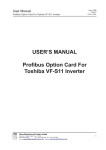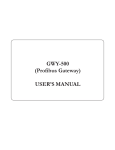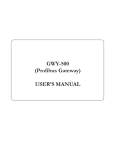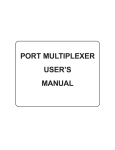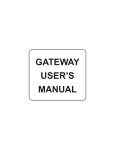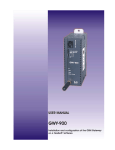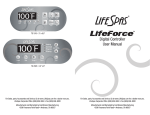Download USER'S GUIDE Profibus Option Card For Toshiba VF
Transcript
Profibus Option Card USER’S GUIDE Profibus Option Card For Toshiba VF-S11 Inverter Profibus Option Card Thank you for purchasing Profibus Option Card. This manual gives you a quick overview of the Profibus Option Card model. Read this manual thoroughly before installing and operating the unit. This document is based on information available at the time of it’s publication and may not cover all the details or variations in hardware or software. Renu Electronics reserves the right to update information in this publication without prior notice. Manual Revisions If you contact us in reference to this manual, please include the following name and revision number Name: Profibus User’s Manual Doc. No.: UMAN\GWY\1005 Rev. No.: 0 Part Code: URML203 We hope that you find this manual informative. If additional information or technical assistance is needed please contact: Renu Electronics Private Limited Survey No. 2/6, Baner Road, Pune – 411 045 Maharashtra, INDIA Tel: +91 20 729 2840 Fax: +91 20 729 2839 E-mail: [email protected] Website: www.renuelectronics.com (i) Profibus Option Card Contents 1. OVERVIEW 2. SPECIFICATIONS 2.1 Specifications 1 3 4 3. APPLICATION 5 3.1 3.2 6 9 Applications Port Details 4. OPERATION 10 4.1 4.2 11 28 Operation Mounting 5. FOR FIRST TIME USER 5.1 5.2 5.3 5.4 5.5 5.6 Introduction to Profibus Protocol Architecture Device Type Profibus DP Characteristics 5.4.1 Bus Access Protocol 5.4.2 Data Throughput 5.4.3 Diagnostic Functions 5.4.4 Protection Mechanism 5.4.5 Network states Device Database files Profiles 29 29 30 31 31 31 33 33 34 34 35 36 10 Profibus Option Card 1. OVERVIEW In this Chapter Overview 1 Profibus Option Card Profibus Option Card allows Toshiba VF-S11 Inverter to act as Profibus DP- Slave on Profibus network. It connects on a control PCB of VF-S11 Inverter using 24pin connector and provides Profibus DP- Slave port [9 pin D Sub] along with the standard serial communication port [8 Pin RJ45 for Option Unit], Contact Input (F, R), Analog Input (VIA) , 24 VDC Power supply and CC [ 5 Pin Terminal Block]. It also provides relay Output (FLA, FLB, FLC) that can be assigned as fault output [3 Pin Terminal Block]. This Option Card communicates with the VF-S11 Inverter (Control Card) and fetches various parameters and makes them available on Profibus DP- Slave port. Control actions such as, RUN/STOP, Frequency Direction (FORWARD/REVERSE), Frequency Command, Emergency Off, Reset etc. can also be issued by Profibus master PLC or any Profibus master Device to VF-S11 Inverter through Profibus Option Card. If user connects Toshiba Option Unit (eg. TYPE-FORM : RKP001Z-0) to standard serial communication port [8 Pin RJ45] while Profibus slave port is active, Processor on Option Card detects the Option Unit (Using CD line) and stop Profibus communication and allows Option Unit to communicate with the VFS11 Inverter. As soon as the Option unit is removed, Profibus communication is restored again. 2 Profibus Option Card 2. SPECIFICATIONS In this Chapter Specifications 3 Profibus Option Card 2.1 Specifications Power LEDS Communication Ports COM1 COM2 Profibus Baud Rate GSD File GSD File Name I/O data *Inverter ID Operating Temperature Storage temperature Humidity Certifications Immunity to ESD Immunity to Transients Immunity to Radiated RF Immunity to Conducted RF Emissions : 24V , 100mA from VF-S11 Control Card. : 3 LEDs for status indication : 2 communication ports as : RJ-45 for Option Unit [TYPE-FORM : RKP001Z-0] Or for Project Download and Firmware Up gradation (Using CMOS-232-01-00, Renu Electronics Make) : 9 Pin D-Sub (2 wire RS485) Profibus – DP slave DPV0 (Cyclic Communication) : 9.6k, 19.2k, 45.45k, 93.75k, 187.5k, 500k, 1.5M, 3M, 6M, 12M Bit/s (Autodetect) : Supplied with the unit : RENU0A0E.GSD : 100 Word Input, 100 Word Output : 0 - 125 (At power ON, station number is detected automatically) : 0OC to 60OC : -20o C to 80oC : 10% to 90% (Non condensing) : CE : Level 3 as per IEC1000-4-2 : Level 3 as per IEC1000-4-4 : Level 3 as per IEC1000-4-3 : Level 3 as per IEC1000-4-6 : EN55011 CISPR A *Note: Inverter ID should be unique, when there are multiple inverters connected in the network. (Isolation between communication ports and Power supply, throughDC-DC coupler is 1 KV) (Isolation between communication ports (Option Port and Profibus Port), through optoisolation is 1KVfor 1 min) 4 Profibus Option Card 3. APPLICATION In this Chapter Applications of Profibus Card Port Details 5 Profibus Option Card 3.1 Applications 1. Profibus Option Card allows VF-S11 Inverter to act as Profibus DP- Slave on Profibus network 2. Toshiba Option unit can be connected to Profibus Option Card on Option Port. 6 Profibus Option Card Inverter Settings Required for Option Card: The following is a list of the parameter settings that are required during setup to enable Profibus communications: Parameter Required Value F800 3 F801 1 F802 1 If drive control (frequency command input, RUN/STOP, etc.) is to be performed via the Profibus network, the following drive parameters must also be set as shown: Parameter Required Value Fnod 4 Cnod 1 As is the same with all other communication configuration parameters, the drive must be reset after making the parameter changes described above in order for the changed settings to be enabled. 7 Profibus Option Card Using Profibus Option Card You can monitor and control following parameters but not limited to Monitoring Parameters: Inverter Parameter Profibus Input Dataword Output Frequency I000 Output Power I001 Acceleration Time1 Monitoring I002 Decelaration Time1 Monitoring I003 Output Voltage I004 Output Current I005 Controlling Parameters: Inverter Parameter Profibus Output Dataword Command Frequency O000 Run / Stop O001 Accelaration Time1 Setting O002 Decelaration Time1 Setting O003 Frequency Direction O004 Note: Using Gateway Configurator User can add, map and download required parameters into Option Card. I000 represents the first word of the Input Area and accordingly the remaining. O000 represents the first word of the Output Area and accordingly the remaining. Please refer Project described on page no 11. 8 Profibus Option Card 3.2 Port Details Profibus - DP Slave 5 9 5 4 A(+) DATA 8 +5VDC* Supply voltage for terminator resistance) 6 3 6 1 1 DATA Ground RTS (TTL Direction Control for repeaters) B (+) Data Line Shield / Functional Ground DB9 Female Data Line: The Profibus user group recommends the following colour coding for the data signal lines: A-Data Line = Green B-Data Line = Red These data signal lines must be connected to the corresponding signal terminals or pins at the master unit and other stations (i.e.A to A, B to B). RTS: The signal RTS (TTL signal relative to Data Ground) is meant for the direction control of repeaters in case repeaters without self control capability are used. +5V DC, Data Ground: The signals +5V DC and Data Ground are meant to power an externally mounted bus terminator. The powering of the 220 © termination resistor ensures a defined idle state potential on the data lines. To ensure proper functioning up to the highest baud rate, each bus segment has to be terminated at both ends of the cable. +5V DC 300 Ohm B - Data Line 220 Ohm A - Data Line 300 Ohm Data Ground 9 Profibus Option Card 4. OPERATION In this Chapter Operation Mounting of the unit 10 Profibus Option Card 4.1 Operation For monitoring and controlling the parameters of VF-S11 Inverter you have to download the project through Gateway Setup software. The Gateway project is as follows- 11 Profibus Option Card How to upgrade the firmware and Download the project? For upgrading the firmware and downloading the project You need 1. Gateway Setup Software System Requirements For Gateway Setup Software Windows Version Processor Hard disk Space Mouse RAM Display resolution Display colors : Microsoft Windows 9x/NT/2000/XP : PENTIUM or higher : 5 MB or more : Required : 16 MB or more : 800 X 600 (VGA) or better : 16 bit color 2. CMOS-232-01-00 cable 3. VF-S11 Inverter 4 Pofibus Option Card Procedure: 1. Connect short link between 2 And 3 of JP13 and Jp14. 2. Remove short link on JP15 as per following picture. 3. Connect CMOS-232-01-00 cable between COM port of PC and Option port of Profibus Option Card. You can download the firmware and project with Gateway Setup software. NOTE: At runtime, connect short link between 1 and 2 of JP13 and JP14. Also connect the short link on JP15 as per following picture. 12 Profibus Option Card At Run Time: 13 Profibus Option Card Setup Of Profibus Option Card with Omron Profibus Master For Profibus communication, user needs the software Cx-Profibus. You need to enter the password as “password” (default), you can also change that. The steps for configuration of Profibus network are as follows 14 Profibus Option Card 1 First user has to install the GSD file for Profibus slave module. View – Device Catalogue – Install GSD file 15 Profibus Option Card 2 Then user should form the network that consists of master and slave module. Select the module - Add Device to the network 16 Profibus Option Card 3 Profibus slave module is configured. (a) In Configuration tab, configure the Input and Output modules. (b) In Parameter tab, keep it to common. (c) In Group tab, assign the group for the slave, for global commands. 17 Profibus Option Card 4 Profibus master module is configured next 18 Profibus Option Card • Configuration should be done as shown in images. 19 Profibus Option Card • You can change the baud rate in Bus Parameter tab. • In Omron master, some area is assigned for Input (Input to Master) and Output (output from master). 20 Profibus Option Card • In case of this project, it is CIO3300 for Input and CIO3200 for output. The type of PLC and communication port, Baud Rate should be specified in Device setup tab Configure – Device Type – Settings Configure – Network Type – Settings 21 Profibus Option Card 5 Download the parameters in PLC. 6 When The Slave starts communicating with master, the COMM led gets on. 7 User can watch the area CIO3200 and CIO3300 with help of CX- Programmer 22 Profibus Option Card Setup Of Profibus Option Card with Siemens Profibus Master 1 If the slave is not of Siemens family, you need to install the GSD file for it. H/W configuration – Option – Install New GSD You can see the GSD file in Additional Field Devices in Hardware Catalog. 23 Profibus Option Card 2 Next step is to form the Profibus Network. Refer Hardware Catalog for selecting the devices: (a) In Rack 0, slot 2, user should enter CPU (i.e. Siemens Master) (b) Slave module is added in front of Master module. 24 Profibus Option Card 3 You can see the configuration in Hardware Configuration - Option – Configure Network 4 Download the configuration to PLC. 25 Profibus Option Card 5 After downloading is complete, and communication is established, the BF and SF LED goes off. 6. You can monitor the variables as PLC – Monitor/Modify variables. 26 Profibus Option Card 27 Profibus Option Card 4.2 Mounting Before Connecting After Connecting Note: Dont forget to tighten the screw. 28 Profibus Option Card 5. FOR FIRST TIME USER In this Chapter Introduction to Profibus Protocol Architecture Device Types Profibus DP Characteristics Device Database Files Profiles 28 Profibus Option Card 5.1 Introduction to Profibus PROFIBUS is a vendor-independent, open fieldbus standard for a wide range of applications in manufacturing, process and building automation. Vendor independence and openness are guaranteed by the PROFIBUS standard EN 50170. With PROFIBUS, devices of different manufacturers can communicate without special interface adjustments.The PROFIBUS family consists of three compatible versions: High Speed: PROFIBUS-DP DP stands for Decentralised Periphery. It is optimised for high speed and lowcost interfacing, especially designed for communication between automation control systems and distributed I/O at the device level. Process Automation: PROFIBUS-PA PA stands for Process Automation. It permits sensors and actuators to be connected on one common bus line even in intrinsically-safe areas. It permits data communication and power supply over the bus using 2-wire technology according the international standard IEC 1158-2. Higher Level: PROFIBUS-FMS FMS stands for Fieldbus Message Specification. This version is the generalpurpose solution for communication tasks at a higher level. Powerful services open up a wide range of applications and provide great flexibility. It can also be used for extensive and complex communications tasks. Uniform bus access protocol: PROFIBUS-DP and PROFIBUS-FMS use the same transmission technology and a uniform bus access protocol. Thus, both versions can be operated simultaneously on the same cable. However, FMS field devices cannot be controlled by DP masters or vice versa. Note: It is not possible to exchange one of these family members by another family member. This will cause faulty operation. 29 Profibus Option Card 5.2 Protocol Architecture The PROFIBUS protocol architecture is oriented on the OSI (Open System Interconnection) reference model in accordance with the international standard ISO 7498. Layer 1 (physical layer) of this model defines the physical transmission characteristics. Layer 2 (data link layer) defines the bus access protocol. Layer 7 (application layer) defines the application functions DP-Profiles DP-Extensions User Interface Layer (7) Application Layer (6) Presentation Layer (5) Session Layer (4) Transport Layer (3) Network Layer (2) Data Link Layer (1) Physical Layer DP Basic Functions NOT DEFINED Fieldbus Data Link (FDL) RS-485 / Fibre Optics Layer 1, 2 and user Interface: PROFIBUS-DP uses layers 1 and 2, and the user interface. Layers 3 to 7 are not defined. This streamlined architecture ensures fast and efficient data transmission. The application functions which are available to the user, as well as the system and device behaviour of the various PROFIBUS-DP device types, are specified in the user interface. Transmission medium: RS-485 transmission technology or fibre optics are available for transmission. RS-485 transmission is the most frequently used transmission technology. Its application area includes all areas in which high transmission speed and simple inexpensive installation are required. Twisted pair shielded copper cable with one conductor pair is used. Easy Installation: The RS-485 transmission technology is very easy to handle. Installation of the twisted pair cable does not require expert knowledge. The bus structure permits addition and removal of stations or step-by-step commissioning of the system without influencing the other stations. Later expansions have no effect on stations which are already in operation. Transmission speeds between 9.6 kbit/s and 12 Mbit/s can be selected. One unique transmission speed is selected for all devices on the bus when the system is commissioned. Cable Length: The maximum cable length depends on the transmission speed. The specified cable lengths are based on type-A cable. The length can be increased by the use of repeaters. The use of more than 3 repeaters in series is not recommended. 30 Profibus Option Card 5.3 Device Type PROFIBUS distinguishes between master devices and slave devices. Master Devices: Master devices determine the data communication on the bus. A master can send messages without an external request, as long as it holds the bus access right (the token). Masters are also called active stations in the PROFIBUS standard. DPM1, DPM2: There are two types of master devices: DP master class 1 (DPM1) and DP master class 2 (DPM2). A DPM1 is a central controller which exchanges information with the decentralised stations (i.e. DP slaves) within a specified message cycle. DPM2 devices are programmers, configuration devices or operator panels. They are used during commissioning, for configuration of the DP system, or for operation and monitoring purposes. Slave Devices: Slave devices are peripheral devices. Typical slave devices include input/output devices, valves, drives, and measuring transmitters. They do not have bus access rights and they can only acknowledge received messages or send messages to the master when requested to do so. Slaves are also called passive stations. 5.4 5.4.1 Profibus DP Characteristics Bus Access Protocol The bus access protocol is implemented by layer 2. This protocol also includes data security and the handling of the transmission protocols and messages. Medium Access Control: The Medium Access Control (MAC) specifies the procedures which determine when a station is permitted to transmit data. A token passing procedure is used to handle the bus access between master devices, and a polling procedure is used to handle the communication between a master device and its assigned slave device(s). Token Passing: The token passing procedure guarantees that the bus access right (the token) is assigned to each master within a precisely defined time frame. The token message, a special message for passing access rights from one master to the next master, must be passed around the logical token ring - once to each master - within a specified target rotation time. Each master executes this procedure automatically. A user can only change the target rotation time, but is not recommended. Polling Procedure: The polling or master-slave procedure permits the master, which currently owns the token, to access its assigned slaves. The picture below shows a possible configuration The configuration shows three active stations (masters) and six passive stations (slaves). 31 Profibus Option Card The three masters form a logical token ring. When an active station receives the token message, it can perform its master role for a certain period of time. During this time it can communicate with all assigned slave stations in a master-slave communication relationship, and a DPM2 master can take the initiative to communicate with DPM1 master stations in a master-master communication relationship. Multi-peer Communication: In addition to logical peer-to-peer data transmission, PROFIBUS-DP provides multi-peer communication (broadcast and multicast). Broadcast communication: an active station sends an unacknowledged message to all other stations (masters and slaves). Multicast communication: an active station sends an unacknowledged message to a predetermined group of stations (masters and slaves). 32 Profibus Option Card 5.4.2 Data Throughput Transmission Time: At 12 Mbit/s, PROFIBUS-DP requires only about 1 ms for the transmission of 512 bits of input data and 512 bits of output data distributed over 32 stations. The figure below shows the typical PROFIBUS-DP transmission time depending on the number of stations and the transmission speed. The data throughput will decrease when more than one master is used. 5.4.3 Diagnostic Functions Extensive Diagnostics: The extensive diagnostic functions of PROFIBUS-DP enable fast location of faults. The diagnostic messages are transmitted over the bus and collected at the master. These messages are divided into three levels: Device related Diagnostics: These messages concern the general operational status of the whole device (e.g. overtemperature or low voltage). Module Related Diagnostics: These messages indicate that a fault is present in a specific I/O range (e.g. an 8-bit output module) of a station. Channel related Diagnostics: These messages indicate an error at an individual input or output (e.g. short circuit on output 5). 33 Profibus Option Card 5.4.4 Protection Mechanism Time Monitoring: PROFIBUS-DP provides effective protection functions against parameterisation errors or failure of the transmission equipment. Time monitoring is provided at the DP master and at the DP slaves. The monitoring interval is specified during the configuration. Protection Mechanism at the master: The DPM1 master monitors data transmission of its active slaves with the Data_Control_Timer. A separate control timer is used for each slave. This timer expires when correct data transmission does not occur within the monitoring interval. If the master’s Auto_Clear mode is enabled, the DPM1 exits the ’Operate’ state, switches the outputs of all assigned slaves to fail-safe status, and changes to its ’Clear’ state (see also 1-4-5 Network states). Protection Mechanism at the slave: The slave uses the watchdog control to detect failures of the master or the transmission line. If no data communication with the master occurs within the watchdog control interval, the slave automatically switches its outputs to the fail-safe status. This mechanism can be enabled or disabled for each individual slave. Also, access protection is available for the inputs and outputs of the DP slaves operating in multi-master systems. This ensures that direct access can only be performed by the authorised master. For other masters, the slaves offer an image of their inputs and outputs, which can be read by any master, even without access rights. 5.4.5 Network states PROFIBUS-DP distinguishes four different network states. Off Line: Communication between all DP participants is stopped. Stop: Communication between DPM1 and DP slaves is stopped. Only communication between DPM1 and DPM2 is possible. Clear: DPM1 master attempts to set parameters, check the configuration, and subsequently perform data exchange with its associated DP-slaves. The data exchange comprises reading the inputs of the DP-slaves and writing zero’s to the outputs of the DP-slaves. Operate: DPM1 master exchanges data with its assigned slaves, inputs are read and outputs are written. Beside this, the DPM1 cyclically sends its local status to all assigned DP slaves (with a multicast message) at a configurable time interval. Auto_Clear: When an error occurs during the data transfer phase of the DPM1, the ‘Auto_Clear’ configuration setting determines the subsequent actions. If this parameter is set to false, the DPM1 remains in the ‘Operate’ state. If set to true, the DPM1 switches the outputs of all assigned DP slaves to the fail-safe state and the network state changes to the ‘Clear’ state. 34 Profibus Option Card 5.5 Device Database files GSD Files: To achieve straightforward configuration of a PROFIBUS-DP network, the characteristic features of a device are specified in a file. This file is called a GSD-file (Gerätestammdaten file). The language of the GSD file is expressed with the last letter from the extension, *.GS?: Default: =GSD English =GSE Deutsch =GSG Italian =GSI Portugees =GSP Spanish =GSS The GSD files are prepared individually by the vendor for each type of device, according to a fixed format. Some parameters are mandatory, some have a default value and some are optional. The device data base file is divided into three parts: General Specifications: This section contains the vendor name, the device name, hardware- and software release versions, station type and identification number, protocol specification and supported baud rates. DP master-related specifications: This section contains all parameters which only apply to DP master devices (e.g. maximum memory size for the master parameter set, maximum number of entries in the list of active stations, or the maximum number of slaves the master can handle). DP slave-related specifications: This section contains all specification related to slaves (e.g. minimum time between two slave poll cycles, specification of the inputs and outputs, and consistency of the I/O data). Configurator: The device data base file of each device is loaded in the configurator and downloaded to the master device. Refer to the Operation Manual of the PROFIBUS-DP Master Unit for usage of the GSD file in the master’s configuration software. GSD files are usually supplied with each unit. Alternatively, GSD files can be downloaded from the Internet, either from the manufacturer’s site, or from the GSD library of the PROFIBUS Nutzerorganisation at http://www.profibus.com. 35 Profibus Option Card 5.6 Profiles Exchanging Devices: To enable the exchange of devices from different vendors, the user data has to have the same format. The PROFIBUS-DP protocol does not define the format of user data, it is only responsible for the transmission of this data. The format of user data may be defined in so called profiles. Profiles can reduce engineering costs since the meaning of application-related parameters is specified precisely. Profiles have been defined for specific areas like drive technology, encoders, and for sensors / actuators. 36








































